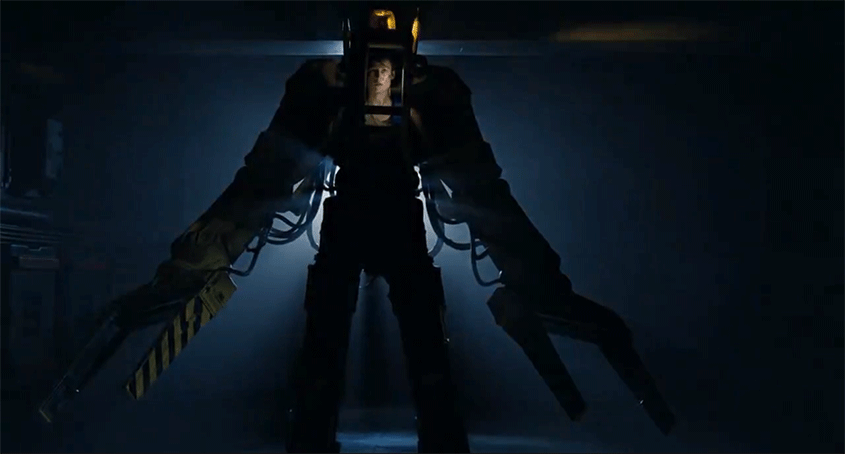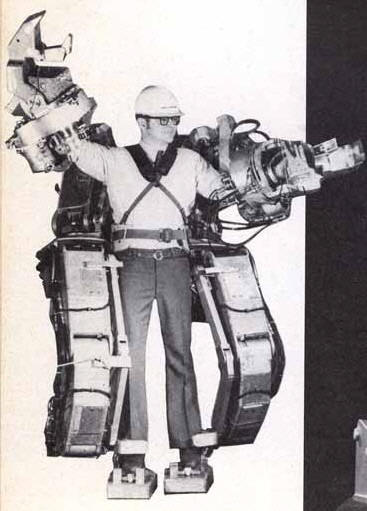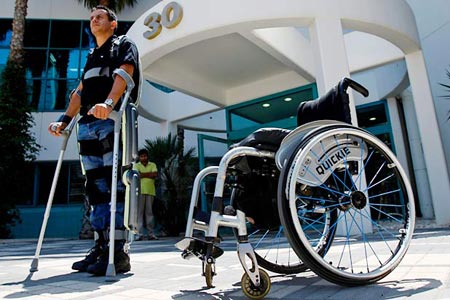Matt Damon’s latest film, Elysium, is set 140 years in the future where society is divided between the elites, who live in a utopian orbital society, and the rest of us, who struggle in squalor down on the planet’s surface. To combat this inequality, an unsung hero installs himself into a full-body prosthetic and breaks into the “most secure place in the universe.” Must be one hell of a suit.
The movie may be both set a century and a half henceforth and pure sci-fi. but the technology that it’s based on is very real. In fact, the movie’s HULC suit (Human Universal Load Carrier) is closely modelled after the US military’s own design — of the same name.
“The whole suit is just an extrapolation on current-day technology that the military is looking into,” Elysium director Neill Blomkamp told Yahoo! News. “It’s like a ‘power assist’ suit that helps you lift heavier objects or jump higher or run quicker.”
Extrapolations are one thing. How close are we to this being a reality?

What Are Power Suits?
Power suits like the HULC, also known as powered exoskeletons or simply exosuits, are wearable machines designed to augment the user’s strength and (at least theoretically) agility using either electronic or pneumatic actuators. These devices typically employ hydraulics controlled by an onboard computer.
In practice, soldiers wearing a perfected exosuit would be able to carry hundreds of pounds of gear over inhospitable terrain at a high rate of speed without breaking a sweat. Elder care nursing staff would be able to lift and move bedridden patients without having to fold them into a wheel chair. Surgeons could eliminate hand tremors during delicate surgery. Construction crews would be able to move heavy materials without relying on cranes and other heavy machinery. In short, they can change our lives forever, in every conceivable way.
Unlike Luke Skywalker’s animatronic hand or Ash’s gauntlet, exosuits only augment existing abilities; they don’t replace lost function. Think Ripley’s Aliens Power Loader. They also rely on external stimuli, instead of the neural networking techniques that DARPA is experimenting with help control advanced prosthetics. Lastly, you shouldn’t confuse exosuits with mechs like as Gundams, Gunmen, or Jaegers. Mechs are essentially humanoid vehicles, complete with cockpit and conventional control systems. They’re not physical augments.

The First Exosuits
We’ve been enamoured with feats of superhuman strength since the dawn of time (see: Samson, Hercules, Hulk, Colossus). But with biological tampering being both scientifically out of reach and ethically controversial, people have been tinkering with mechanical solutions since the late Victorian era.
In 1890, Russian inventor Nicholas Yagin developed the first known exosuits. These passive devices used compressed gas bladders to assist the user in walking, jumping and running, respectively. The first credited US exosuit inventor was Leslie C. Kelley, who debuted a model in 1917 that utilized steam power and rubber ligaments to enhance the wearer’s abilities. These early iterations were crude at best and, while cutting edge for their day, far too cumbersome and energy intensive to be of any real use.

It wasn’t until the 1960s that the modern power suit concept emerged. General Electric, working in conjunction with the Department of Defence, created the Hardiman, a bulky contraption that looked not unlike a pair of automotive assemblers strapped to the user’s back and legs. While clunky by any measure, it managed to reduce exertion by a factor of 25, which is quite impressive. That is, lifting 250 pounds in the hydraulic suit felt like lifting 10. It was also one of the first devices to offer a funky new feature called “force feedback,” to prevent the user from crushing items in his grasp.
But for as promising as the Hardiman concept was, it never really panned out. It weighed three quarters of a ton — nearly twice its own liftable limit — had a walking pace that only covered 2.5 feet per second, and employed a cumbersome, delay-ridden, master-slave command system. It was a great idea, but the technology needed to make it truly functional simply had yet to be invented.
Hardiman was followed first by Project Pitman, built by Los Alamos Laboratories in the 1960s, and subsequently the Lifesuit in the mid-1980s. Monty Read, a US Army Ranger paralysed during a parachute accident, came up with the idea for the Lifesuit after reading Robert Heinlein’s Starship Troopers (specifically the bits about the Mobile Infantry Power Suits) while in recovery. He submitted his proposal to the Department of Defence, which incorporated it into its R&D efforts over the next two decades.

By 2003, the early Lifesuit One (LS1) models were able to seamlessly match the wearer’s gait. In 2005, the system set the Guinness World Land Speed Distance Record for walking in robot suits when Reed completed the 3-mile Saint Patrick’s’ Day Dash in Seattle in just 90 minutes. Not bad for a guy with a broken back. Today, the Lifesuit’s latest iteration, the MK 14, can walk a mile on a full charge, and lift up to 200 pounds.
The State of the Art
Getting an exosuit development project off the ground is no small feat, and as such is only really undertaken by governments and top-tier defence contractors. On the military front, Sarcos and Raytheon have teamed to make XOS suit; Lockheed Martin, meanwhile, has concentrated its efforts on the real-life HULC suit.
On the civilian side, Cyberdyne Inc (no not that one) has already developed and begun rolling out the HAL 5 (no, not that one either) for use in elder care facilities. While none of them is quite powerful enough to tackle dystopia yet, they each come surprisingly close in their own way.
The XOS
The XOS Exoskeleton, originally developed as the Wearable Energetically Autonomous Robot (WEAR) by Sarcos Research of Salt Lake City, is a full-body, aluminium and steel suit that augments the user’s strength and agility. The device itself weighs just 200 pounds and allows the user to lift up to the same amount with a 17-fold decrease in exertion (lifting 200 pounds feeds like lifting less than 12). The XOS relies on high-pressure hydraulics to perform its amazing feats of strength — like punching through thee inches of wood.
The HULC
Lockheed’s HULC suit, on the other hand, weighs just 53 pounds but grants its user the same 200-pound carrying capability. The power comes compliments of a backpack mounted to the titanium frame, not the user. This reduces stress to the legs and back, one of the most common injuries to soldiers. The fully untethered device runs on an onboard battery pack, and will allow the wearer to march at 3MPH and perform short, 10 MPH burst sprints. To be fair, NFL players can hit 25 MPH in bursts too. But they’re a lot more winded by the end of it.
The Hal 5
Cyberdyn’s Hal 5 system is an exclusively medical version of the exosuit. Originally developed by Dr. Sankai, a professor at Tsukuba University, it’s been designed specifically for assisting people with disabilities. The full-body suit can increase a user’s natural strength tenfold. The Hal 5 underwent hospital trials in Japan last year, becoming the first exosuit to achieve global safety certification in this past February.
The Next Augmented Step
With the numerous advantages they offer, exosuits are quickly moving towards widespread adoption — first among the military and then, eventually, by civilian industry. As bionics expert Thomas Sugar, associate professor at the Department of Engineering, Arizona State University, told CNN:
In the next five years we’re going to see more and more exoskeletons out there in practice… If you live near where I do and want to go out and hike the Grand Canyon, exoskeleton devices 10-15 years from now could assist you to do that.
That is, of course, is assuming science works the bugs out first. Exosuits have a number of current technological shortcomings that must be addressed before they can be effectively implemented, especially to the degree they are on the big screen.
For one thing, exosuits have to toe a delicate line between structural integrity and weight savings. Exosuit innovators are faced with a choice: Steel-built systems are far stronger, but also far heavier than their aluminium counterparts. This makes them less likely to catastrophically fail under load, folding the user into a bloody pretzel, but also requires far more energy to move. The same can be said for the suit’s joint actuators. Current hydraulic cylinders are powerful but very heavy, not to mention that the fluids they use are both heavy and have a habit of leaking, leaving the actuator limp and useless. Pneumatic (gas powered) actuators are a lighter-weight option, but are far to imprecise for this sort of work.
Even something as basic as finding a suitable power supply is proving to be a bit of a challenge. It’s really the same issue every mobile device maker — from Motorola to DARPA — currently faces: A shortage of sufficient energy capacity. Li-ion batteries are the fashionable choice but they’re heavy, inflexible, and rather cumbersome given the few short hours worth of juice they can hold. The suits could theoretically be powered by kinetic energy generation (itself barely more tangible than vaporware), internal combustion engines, even steam like the Kelley suit from 1917. But until we get to the next big thing in lithium air technology, we’re going to be stuck right where we are.
Lastly, there’s the whole other issue in the platforms’ response rates. The Hardiman had a lag time of well over a second. The HULC and XOS are both far faster than that, but they still present a noticeable lag. “If you look at some of the devices out there, they’re actually quite hard to walk in,” Sugar continued to CNN. “You’ve got to make sure they really enhance people’s abilities.” Based on the Elysium trailer, the fights Matt Damon gets in would require totally fluid movement; even fractions of a second lost could mean death.

But these technological shortcomings are merely bumps in the road. As our technical prowess advances, leading to better energy storage solutions, enhanced brain-to-computer interfaces (BCI), and stronger, lighter alloys, exosuits have the potential to become ubiquitous tools for future generations. And they might just pull us up out of the rubble someday.
[Army Technology – Wikipedia – CNN – Yahoo – Lockheed Martin]
